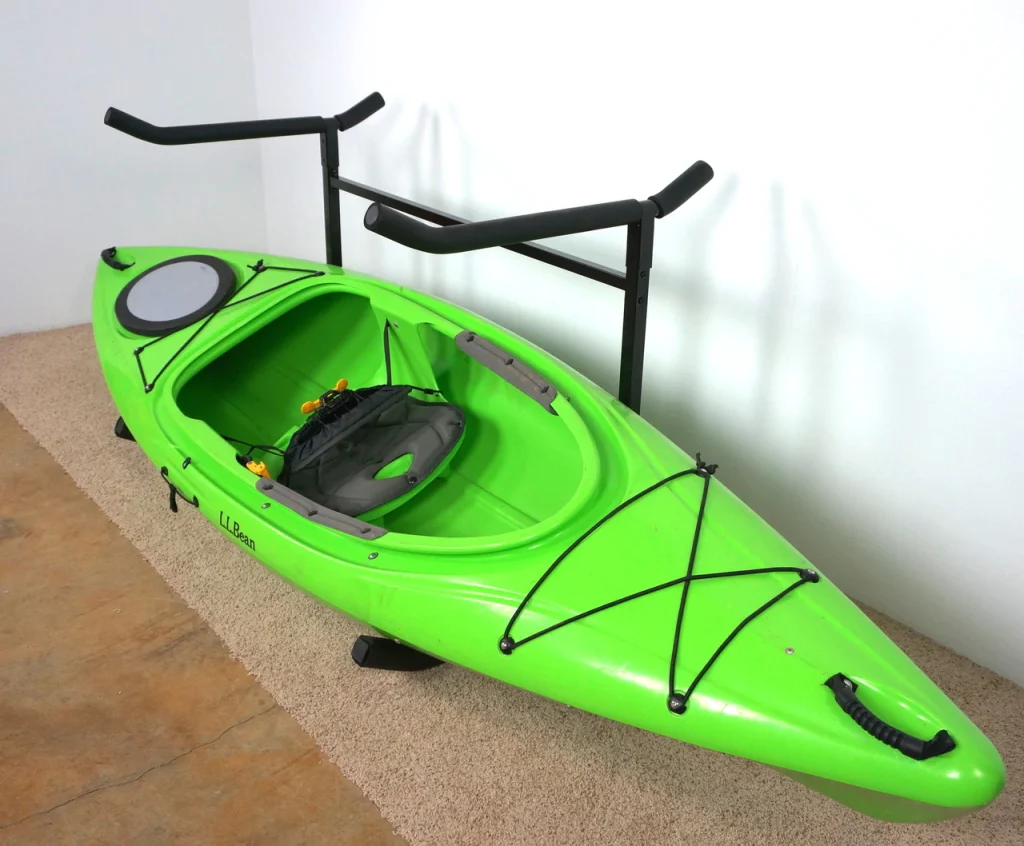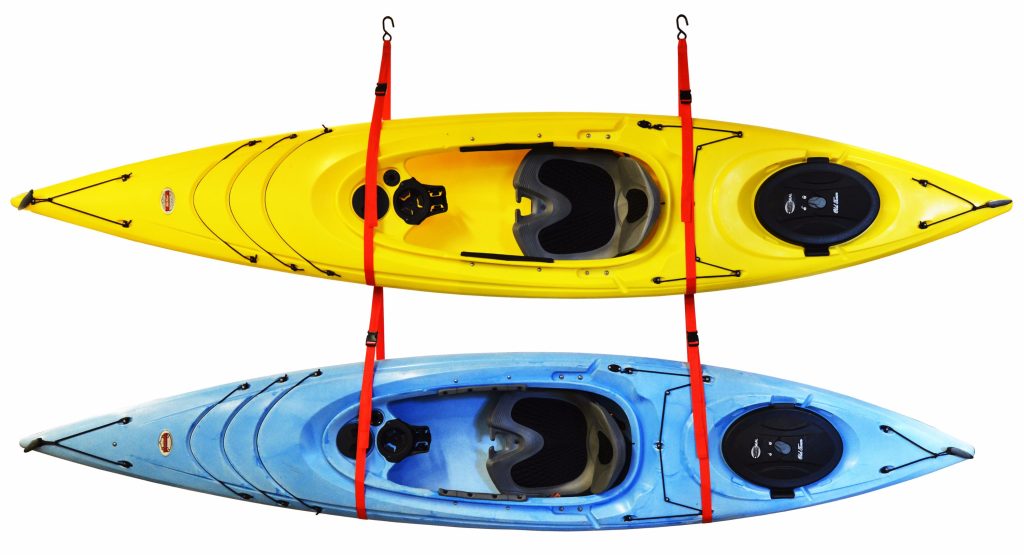In some parts of the world, kayak anglers face horribly cold and windy wintertime fishing conditions, including hard-frozen water, which makes kayak fishing not only unpleasant, but dangerous. These folks will need to store their “yaks” for the winter and pray for spring to come early. Where I’m from on the Gulf Coast, winter is much better to deal with than the frozen north’s cold season. Still, most of us have to store our kayaks from time to time and choosing the best kayak storage rack for our needs can make a big difference when it comes time to take the boat back on the water.
Take A Stand and Some Hang-ups
Whether we’re looking at long-term storage of a kayak or just short term “in-between” fishing trip storage, if the owner has room for the kayak to be stored inside say in a garage, the best storage arrangement will likely be either a free-standing rack or a wall or ceiling mounted hanging system.
There are many ready-made storage racks for kayaks which can be found on-line or at local kayak shops and with a little time and study, owners can make perfectly suitable and functional stands for their kayaks out of 2X4s and some hardware.

These floor-racks are really easy to assemble and, if done properly, can support kayaks well. The purchased racks often have rollers so the entire rack with kayaks loaded can be moved from location to location on a smooth floor. These free-standing racks can be purchased for between $150 for single kayak racks to around $325 for multiple-kayak racks.
Many times kayak owners don’t have floor space available for kayak storage, but walls in garages or sheds are an option. There are many inexpensive kayak wall mounts or ceiling mounted hanging systems which support a stored kayak quite well. The kayak wall hangers mount either to the wall or ceiling structures, and they provide good, solid support for kayaks.
These inside storage systems are not elaborate, and as long as they support the kayak from end to end and on both ends, they will do just fine.
Kayaks stored indoors need to be well-removed from any source of heat. Furnaces, space heaters, even exhausts from motors can create enough heat to severely damage a kayak.
Outdoor Kayak Storage Rack
Kayaks are tough boats, and they don’t have to be babied. With proper precautions, kayaks can be stored outside with no problems.
Basically, kayaks stored outdoors need to be protected from sunlight while in storage. Long-term exposure to the UV rays of even our wintertime Southern sun can damage the finish of both fiberglass and plastic kayaks. Kayaks stored outside need to be covered totally. The kayak needs to be protected from rainfall, blown rain, and leaves while in storage. Kayaks that are allowed to fill with rain water can be permanently deformed and warped from the weight of the water if it fills the hull, and even just a little water in a kayak can create problems if allowed to sit for long periods.

And while kayaks stored outdoors need protection, they don’t need to be tightly wrapped in a tarp or other cover. This allows moisture to collect from rain and condensation, and this can be hard on kayaks especially those with foot steering or pedal drive systems. Some good air-flow is best for outdoor stored kayaks.
Kayak owners who have to store their boats outside can look at places which offer some protection. Under decks can be good as can below the eaves and overhangs of roofs- just make sure the kayak does not receive a lot of water run-off from rain storms if stored in these locations. It doesn’t hurt a bit to store a kayak upside down. This can help prevent hull-warping, and an upside down kayak can’t collect rain or other water.
Even a hanging systems between two trees will work if the kayak is fully supported in the middle as well as at the ends. A tarp suspended above the hanging kayak will keep it dry and shaded.
Some Things to Consider
For short-term kayak storage, just about any place that has the kayak out of the way and secure will work. A kayak won’t come to much damage if the time between trips is short- just a few days or a week.
However, for longer term storage. There are some things to keep in mind.
First, don’t leave the kayak flat on its bottom unsupported on the floor or ground. This can flatten out the kayak’s hull and damage its paddling performance.
Next, don’t hang the kayak by its grab-loops for long periods of time as this also can warp the hull. Have straps which properly support the kayak amidships as well as the ends. If the kayak is to be stored long term, it doesn’t hurt to take it down and relocate the support straps from time to time. Make sure the supports are padded so the kayak hull is not resting on a sharp edge. There’s no reason to have a stored kayak tightly strapped. Any kind of tight binding can again warp the hull if the boat has to bear the pressure for a long time. And don’t pile tools or other heavy gear on top of a stored kayak.

When getting a kayak ready for long-term storage, clean it up. Wash the hull with mild soap and get all of the dirt and fish slime off before storing it. And use some lubricant on any moving parts. This is especially needed for pedal-drive kayaks and kayaks with cable-system steering.
For us kayakers who live on the Gulf Coast during hurricane season, take a little advice from me about kayak storage. I made a really neat multi-kayak storage rack in my boathouse for my paddle boats to safely rest away from wind and water from the tropical storms.
And it worked, up until the point the massive sweet gum tree located next to the boathouse decided that it was time to die and so fell during the wind of Hurricane Sally directly across my boathouse. What had been a nice safe rack of four kayaks became a horrible flattened mess of smashed fiberglass and plastic. When storing that kayak, try to put it somewhere away from potential fallen trees.
Even though we’re looking primarily at the kayak itself, we need to keep everything else used on kayak fishing trips in mind. Paddles and other important kayaking gear needs a little attention, too.
Take all soft material elements, seat covers, tackle bags, storage bags and other accessories off the stored kayak and, if possible, wash them up. Paddles can always use a little lubricant applied to the joint so the parts will slide apart and together easily. Of course, any electronics such as depth finders, GPS units and so on should be removed and safely stored.
And Perhaps the Biggest Thing to Keep in Mind
While most Southern kayak anglers will not have many problems from their stored kayaks suffering physical damage, there’s something else to really keep in mind.
A kayak left exposed and unattended is a very attractive target for thieves. I’ve had a kayak stolen, and it seems that a stolen kayak is next to impossible to trace and locate. So the best thing we can do is make it very difficult for a low-down kayak thief to access our stored boat.
Try to locate a storage spot that is hidden or locked up. Don’t store the kayak in the front yard, front porch, or other obvious spot. Behind the house or in thick cover can be much better.

Also, make sure the kayak can be easily reached. A place away from the road or street is good, and having trees, bushes, or other obstructions to make a quick “Grab and go” difficult is good.
Of course, the most obvious thing to make a stolen kayak less likely is to have it locked. A strong cable-lock is good. Just don’t run the cable through a grab-handle and assume it’s secure. It doesn’t take long to cut through a handle cable, with a pocket knife, and with the lift-cable cut, the cable lock is useless.
Instead, run the lock-cable through a scupper in the hull and then around something very solid- like a tree or a solid building support. If a potential thief has to work too hard, he probably won’t steal your kayak.
Full Disclosure: This post may include affiliate links. There’s no extra charge to our readers for using these.



